Publishing podcasts using MediaPub
How to use the mediapub.it.ox.ac.uk website to publish audio and video podcasts to Apple Podcasts and podcasts.ox.ac.uk
To help you publish your podcast using MediaPub, we have organised the following help topics:
- Introduction
- MediaPub RSS system
- Uploading your podcast
- Using the dashboard
- Creating a podcast series
- Adding a podcast episode
- Adding a document to an episode: PDF, ePub, captions file (.srt), text file
- Submitting a media file (audio or video)
- Adding and removing maintainers to a series
- Links to your series and episodes
- Generating an RSS newsfeed
- Apple Podcasts (formerly iTunes U) series statistics
- Embedding audio/video podcasts ("embed code") into HTML
Introduction
Before users can listen to your podcast it requires some means of publication. The most common way to publish a podcast is by using an RSS feed, which is a special file that points to the podcast (the MP3, MPEG4 etc.) and contains your description of the podcast's content.
The University of Oxford provides a cataloguing and publishing tool MediaPub (website) which generates RSS and manages the University media publishing workflow.
MediaPub allows University members to publish audio and video podcasts to the following University channels:
- University of Oxford Podcasts website
- University of Oxford site on Apple Podcasts
- And through RSS feeds into department websites
As a summary, you should already have the following items before publishing:
- An audio and/or video media file for your podcast
- Accompanying accessibility files: a transcript for an audio file, a Closed Captions file for video (and optionally a transcript). For advice on generating these please see the 'Podcasting and Accessibility' support page.
- Information about the media: title, description, speakers, keywords, etc
- The URL of the media file. If you need help we could host the podcast for you in a University online repository. Please contact podcasts@it.ox.ac.uk for more information.
- Signed Speaker Release forms for all contributors. Download the legal release form for contributors.
MediaPub can be used then to add podcast episodes to an existing departmental series, or a new series can be created.
To understand how Oxford University IT Services can help you to deliver a successful podcast, see the overview of the Media Publishing service on our Podcasting and Media Publishing page.
MediaPub RSS system
MediaPub is a cataloguing engine and RSS newsfeed generator for podcasts and ebooks from the University of Oxford. It was built using Drupal 7 and replaces the podcasting functionality of OxITEMS. MediaPub feeds can be subscribed to by digital media players allowing the end user to receive podcasts etc. without the need to visit the originating website themselves.
The best way of discovering how MediaPub can help you cataloguing and publishing is watching the MediaPub training video.
Uploading your podcast
The first step the author has to make is to upload the podcast to their webspace, e.g. a college server, their user webspace, or to a course area on the VLE. Or, you may submit the media file that is the podcast to Educational Media Services, and we will host the podcast for you on our own server. Once the location of the podcast is known, follow the instructions below.
Using the dashboard
Go to the MediaPub website. After you have logged into MediaPub using your Oxford Single Sign-on (SSO) you will see your dashboard.
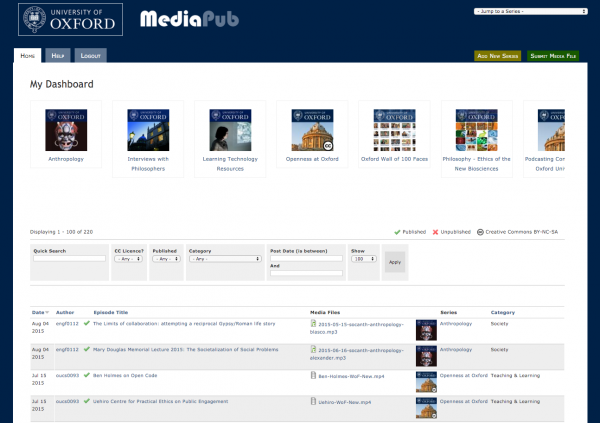
Figure 1. MediaPub dashboard
Your dashboard contains two sections. The top section is a horizontal slider of all series of which you are currently a maintainer. Hover over the slider and you will see a scrollbar allowing you to scroll left and right to see all your series. You can also jump to any of your series using the Jump menu in the header of every page.

Figure 2. Series dashboard
Underneath the slider is a paginated list of all podcast episodes in your series, with a description of who authored them. By default these are ordered by most recent, and you can reorder and filter the episodes. From this view, you can quickly see which podcasts have yet to be published/approved by the Educational Media Services team. You can also use the Quick Search box to search for podcasts in your series.

Figure 3. Episodes dashboard
Creating a podcast series
In order to create series on MediaPub, you must first contact podcasts@it.ox.ac.uk and ask to be given the correct permissions. This is a one-off process, and once you have been granted the permissions, you will be able to create as many series as you like. To create a new series, click the Add New Series link in the site header. A list of all your series can be accessed from your dashboard or from the Jump menu in the header of every page.

Figure 4. Jump to a series
To later edit a series title, description or album cover, simply click on the "Edit" tab above the series information.
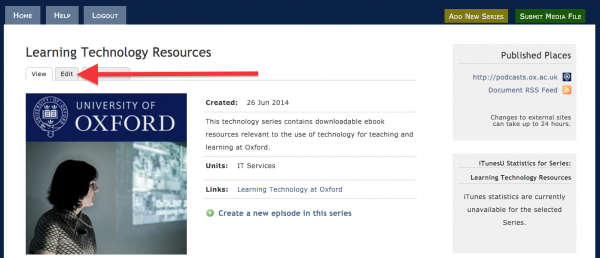
Figure 5. Editing a series
Adding a podcast episode
Once you have created a series, you can add podcast episodes to the series. On the series page, click the “Create a new episode in this series” link.
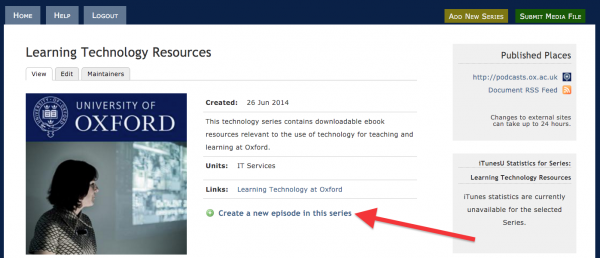
Figure 6. Adding new episode
Each episode will have at least one media file associated with it. The file(s) must be stored on a server and have a publicly-accessible URL.
Educational Media Services is happy to host your podcast media files. Please upload your media file using Mediapub's "Upload Media File" functionality explained below. Alternatively, please email podcasts@it.ox.ac.uk.
You can attach the following types of media files to the episode:
- Audio files: these must be MP3 format (mono, 80 kbps is recommended).
- Video files: they must be MP4 format, H.264 codec, around 840 kbits/sec, 25fps, 640x360 (16:9) or alternatively 640x480 (4:3).
- Document files - PDF: used for slides and sometimes transcripts.
- Document files - ePub: used for ebooks.
- Document files - Closed captions (.srt): these are text files containing subtitles information.
- Document files - text files (.txt): any text file can be attached to an episode.
Before adding a Document file, please read the section 'Adding a document to an episode' below to understand the options.
In a simple use case you might upload just the MP3 of a talk. For video podcasts, we strongly recommend adding an audio-only MP3 version of the podcast as well for people on a limited-bandwidth connection.
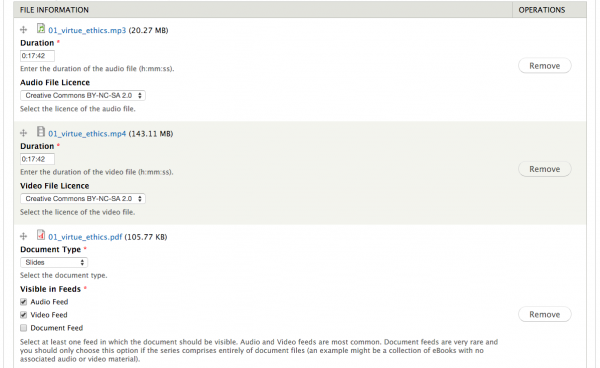
Figure 7. Episode files
If you wish, you can create episodes without media files as “placeholder” episodes and add the media files at a later date. Episodes without media files will not be published in any podcasts until an online file is added to the placeholder field.
By default, an episode will be unpublished and will not be included in any newsfeeds. The episode will be approved and published by the podcasting team after it has been checked for quality, and once we have received a signed release form from each speaker. Please ensure all speakers download the form, complete and sign their individual copy. Download the Speaker Contribution Form here.

Figure 8. Unpublished episodes
Adding a document to an episode: PDF, ePub, captions file (.srt), text file
You can optionally include one or more document files with your podcast episode. The files can be in four file formats:
- PDF: e.g. containing the presentation slides, additional information or a transcript of the episode.
- ePub: a format for ebooks
- SRT-format Closed Captions / subtitles: a text file containing subtitles information, with filename ending .srt
- Text: any plain text file can be attached to an episode (i.e. with filename ending .txt)
Once a document is attached to an episode in MediaPub and published, the document is available for download from the episode's page on the University of Oxford Podcasts site (podcasts.ox). It can also be optionally made available via the series' RSS feed(s).
To add a document file to an episode, it must first be hosted somewhere on the web (often the Media team's 'media.podcasts' server). Paste the URL link into the
Once the episode has been published on MediaPub, in 24-48 hours the document will be available on the episode's page on the University of Oxford Podcasts site (podcasts.ox), as shown below:
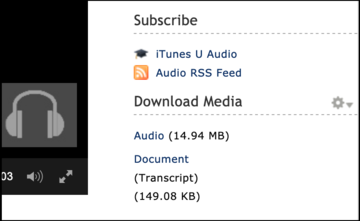
Please note, attaching a captions/subtitles SRT file to an episode via MediaPub does not enable synchronised captions (CC) to be viewed alongside the video. For this you need to upload the SRT file to the Podcasts team via MediaPub, see the section "Upload Media File".
Submitting a media file (audio or video)
As mentioned in the "Adding an episode" section above, each episode can have at least one media file associated with it. The file(s) must be stored on a server and have a publicly-accessible URL.
Educational Media Services is happy to host these files for you. To submit an audio or video file to Educational Media Services, click the "Submit Media File" link in the site header, as seen in the image below:

Figure 9. Submitting a media file
Audio files should be MP3 (mono, 80kbps is recommended), video files must be H.264 MP4 (1280x720p, 1500kbps is recommended). You can also attach PDF or epub document files. PDF files are generally used for transcripts or slides (you can export a PDF of the slides from PowerPoint or Keynote), and epub files are used for ebook.
You may submit only one media file at a time. To submit another file, please submit another media file form. For video podcasts, we strongly recommend adding an audio-only MP3 version of the podcast as well for people on a limited-bandwidth connection. In this case, please submit two media file forms (one for the video, another for the audio-only MP3.
You may submit "edited" or "unedited" files. Unedited files require further editing. Please mark this option on the form if submitting an unedited file. By submitting an unedited file, you are requesting that Educational Media Services complete the editing process of the attached file. If doing so, in the field entitled "File Description & Team Instructions", please describe the file and provide any special instructions to Educational Media Services before submitting the form
Once files have been submitted via the form, the form may not be edited. To re-submit the file with different instructions, or to submit another (or slightly different) media file, please complete an entirely new form with the re-submitted file.
Adding and removing maintainers to a series
After a series is created, you can add additional maintainers by clicking on the "Maintainers" tab above the series, and then click the "Add maintainer" link.
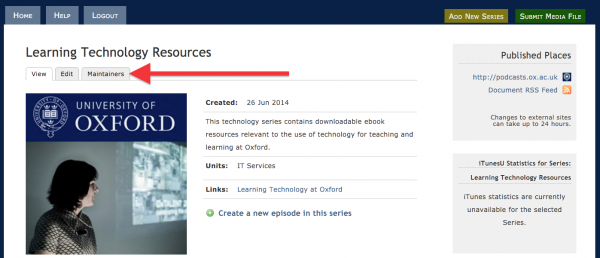
Figure 10. Series maintainers
Start typing the name, SSO or e-mail address to find the maintainer(s) to add. Tick the "admin role" box if you would like the person to have full maintainer rights (in addition to adding new episodes, admins can edit the series information and can edit any existing episodes regardless of who created them). Admin maintainers can also add and remove other maintainers, and edit their roles.
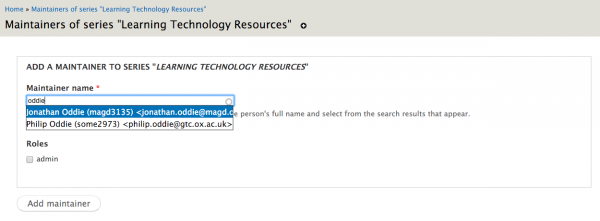
Figure 11. Series maintainers
To remove maintainers or to add/remove series admin privileges, click the "Maintainers" tab, then click the "List maintainers" link. This will give you a list of all maintainers. Click the "edit" links to add/remove admin privileges for that maintainer. To remove maintainer(s) from the series, check the box(es) next to the maintainer(s) you would like to remove, and click the "Remove selected maintainers" button at the top.
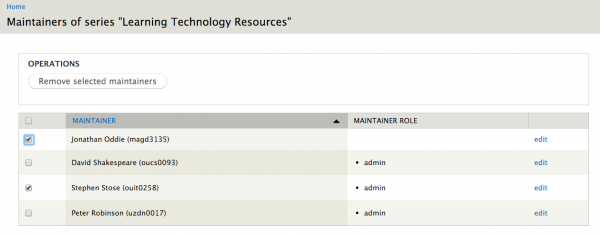
Figure 12. Series maintainers
Links to your series and episodes
After the items have been approved by the Educational Media Services team, they will be published to the different University publishing channels: the University of Oxford Podcasts website and Apple Podcasts. Additionally you can find direct links to the RSS feeds.

Figure 13. Publishing
Series with at least one approved episode will be automatically added to the University of Oxford Podcasts site within 24 hours.

Figure 14. Podcasts.ox.ac.uk series view
Series must be manually created on Apple Podcasts (formerly iTunes U) by the Educational Media Services team and so it may take up to 28 days. Once a series has been added to Apple Podcasts, a link to it will be added to the series page. Please get in touch if your series isn't on Apple Podcasts and you think it should be.
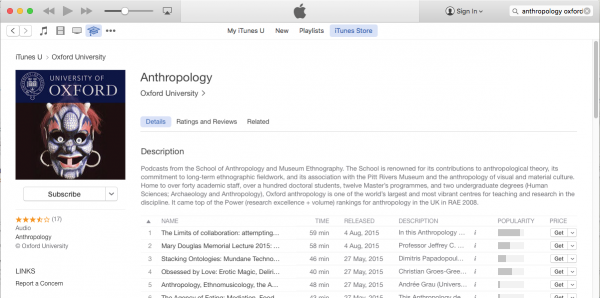
Figure 15. Apple Podcasts / iTunes series view
Generating an RSS newsfeed
RSS newsfeeds are a simple way to get your podcasts into departmental or college websites, and allow people with RSS feed readers to subscribe to your podcasts and receive new episodes as they are added. RSS newsfeeds are generated automatically when episodes are published, and they come in two main flavours - audio feeds (for MP3 audio files) and video feeds (for MP4 video files). Audio and video content is split across separate feeds because Apple Podcasts prefers it this way, and it allows people to subscribe to a lower-bandwidth version of the material if they so wish.
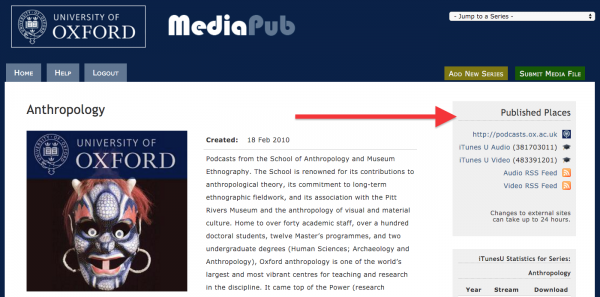
Figure 16. RSS feeds
Although MP3/MP4 files make up the standard outputs for these feeds, both audio feeds and video feeds can also contain PDF or ePub document files for transcripts, slides and eBooks. In the vast majority of cases you will only generate audio and/or video feeds. In very rare cases, when you have only document files in the series, you may generate a document-only feed (an example of a document-only feed is Shakespeare's First Folio).
Apple Podcasts (formerly iTunes U) series statistics
Apple announced the launch of "iTunes U" in 2007. A name change occurred in September 2017, and iTunes U content was integrated with all other Apple podcasting material. Now known as Apple Podcasts, university lectures are delivered via its digital content store.
Apple Podcasts are accessed via the Podcasts app on iPhone/iPad and newer Macs, and iTunes on older Macs and Windows PCs. There are two ways of listening to or viewing Apple Podcasts content: downloading and streaming. Apple Podcasts provides various kinds of user statistics to member institutions (i.e., Oxford University), and Mediapub imports downloading and streaming data on a quarterly basis (approximately).
Mediapub users can view monthly Apple Podcasts downloading/streaming data *up to May 2021* for each of the series they maintain. From May 2021 Apple provide data using different measures and Apple Podcasts analytics data can be requested periodically by emailing Educational Media. Historical download/streaming data is located in the right-hand lower sidebar for each series:
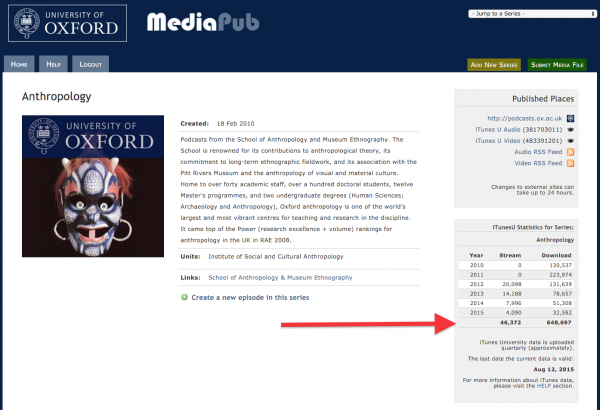
Figure 17. iTunes U statistics for each series you maintain
Downloading and streaming are defined as follows:
Downloading: If a user downloads an audio/video file to a local drive, this counts as one instance of downloading an episode (as part of the series). This should not imply the user actually views/listens to the downloaded audio/video item.
Streaming: If a user, when within Apple Podcasts, "streams" the audio/video file, their computer connects to an ongoing audio/video feed (a "stream"). That is, they do not download the audio/video file to a local drive. Streaming is done by pushing "play" within the user's browser (or iTunes application) while the user is connected online. This should not imply the user views/listens to the audio/video content in its entirety.
[Note: Apple's iTunes U (now Apple Podcasts) did not provide "streaming" data prior to 2012. For this reason, prior to 2012, your series will report zero (0) for streaming data. "Download" data exists from Oct 2008.]
Embedding audio/video podcasts ("embed code") into HTML
In order to insert audio and video content into your own site, social media makes use of what are known as "embed codes." Embed codes are small snippets that you can place within HTML content, such as a web page or blog post. They provide a way to insert interactive audio-video content within your own website without having to design a thing. For instance, the following is an embed code taken from the "sharing" section of a YouTube video:
<iframe width="560" height="315" src="https://help.it.ox.ac.uk/%3Ca%20href%3D"https://www.youtube.com/embed/xcwJt4bcnXs%22">https://www.youtube.com/embed/xcwJt4bcnXs" frameborder="0" allowfullscreen></iframe>
These codes use iFrame, which is an inline frame that can be copy and pasted inside an HTML page to load an HTML widget inside of it. In the above example, the iFrame tag loads YouTube’s video player with the video ID provided in the code (in this case, xcwJt4bcnXs). It defines other parameters as well, such as height, width, frameborder, etc. The parameters will be used by the script which loads the YouTube video player, and you may change these parameters to suit your case.
Below we provide a screenshot that illustrates where the embed codes can be found on any particular episode found on the University of Oxford Podcasts site. As you can see, the red arrows indicate where to click to generate the embed code. Once this is found, copy the embed code to your clipboard.
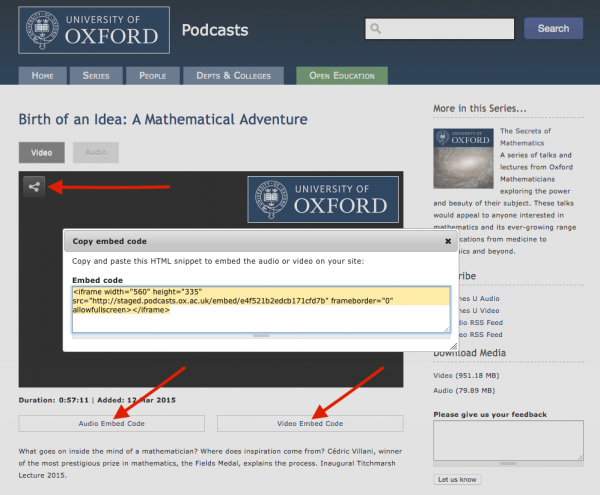
Figure 18. Embed code links on podcasts.ox.ac.uk
Once you have copied the code, you now may paste it into an HTML document. In your content management system (i.e., Drupal, WordPress, HubSpot, etc.), be sure to use the HTML view mode. That is, be sure you are NOT editing in "visual" or "rich text" mode (also known as a "what-you-see-is-what-you-get" or WYSIWYG mode). Instead, you want "plain text" or "HTML" mode (i.e., just the HTML editor). The screenshot below illustrates how the Drupal editor is able to toggle between modes. Other CMS's will have a similar feature. If not, please ask your site administrator to help.
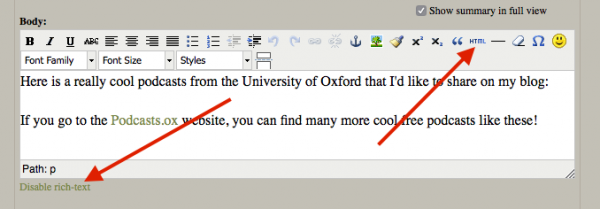
Figure 19. How to switch to an HTML "plain text editor" (WYSIWYG) using a CMS
After clicking on either the HTML button or "disable rich-text" link illustrated above, you may copy your embed code into the HTML page itself, as such:

Figure 20. Copying the embed code into an HTML editor
When switching back to "visual" or the "rich-text" mode, or after publishing your content by saving the newly inserted embed code, the iFrame snippet that you pasted within your HTML code will appear as the audio-video item itself, as seen below:
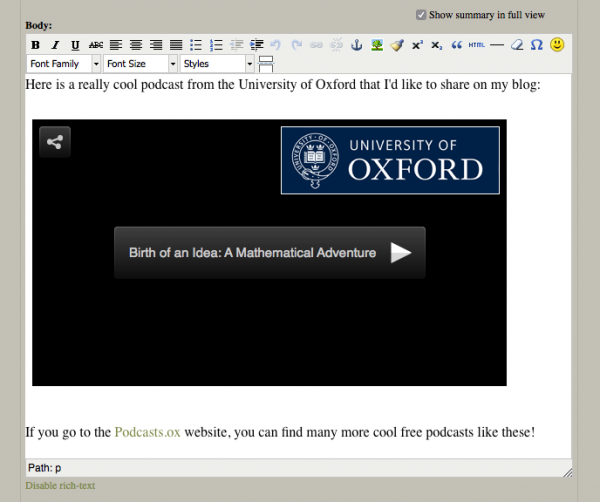
Figure 21. The embed code interpreted as a media object after publishing the content
For further help, see this tutorial on how to insert embed codes into HTML documents.
A note about iFrames: an iFrame is an HTML document which can be pasted into another HTML document, as described above. A web administrator may change the attributes of the iFrame, such as its height, width, and alignment. For more information on iFrames see this W3schools tutorial. iFrames, however, must be used cautiously, and their source must be trusted, given that malicious code may be inserted into iFrame content.
For this reason, some CMS's, such as WordPress, require the use of external add-ons or plug-in modules that re-enable their otherwise restricted use of iFrame embedding. See this tutorial on how to enable iFrames on WordPress.
Drupal allows the use of iFrames, but only if the site administrator has enabled the use of "Full HTML" within the field (usually the body). This can be configured firstly within admin/config/content/formats, and then within individual content types.
For other CMS's, please visit the documentation for the use of full HTML and/or iFrame embedding.
Get support
For help with podcasting and publishing contact Educational Media Services
Local IT support provide your first line of on-the-spot help
Contact us
Educational Media Services
13 Banbury Rd, Oxford, OX2 6NN
Tel: (+44) 01865 289983
Email: media@it.ox.ac.uk



